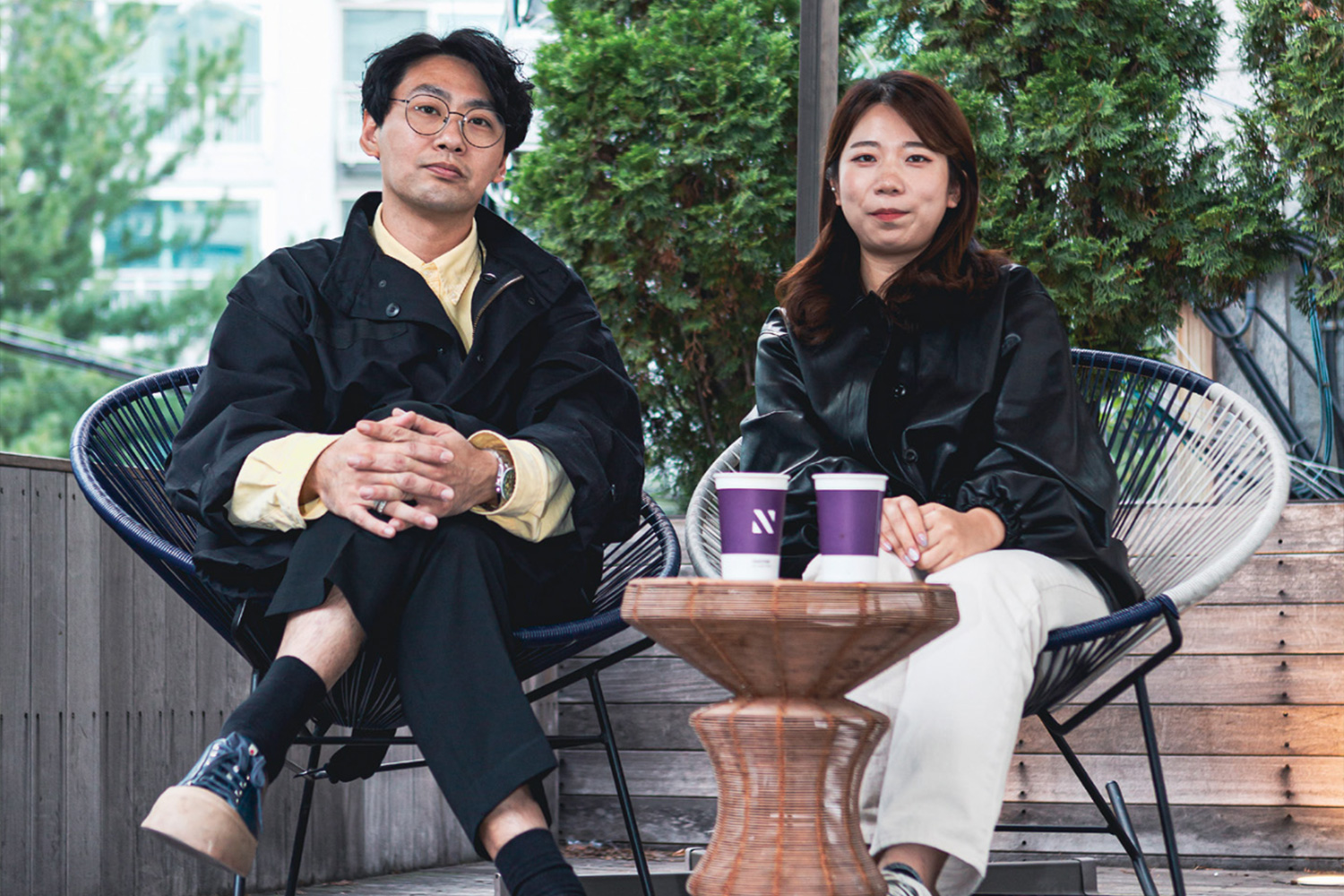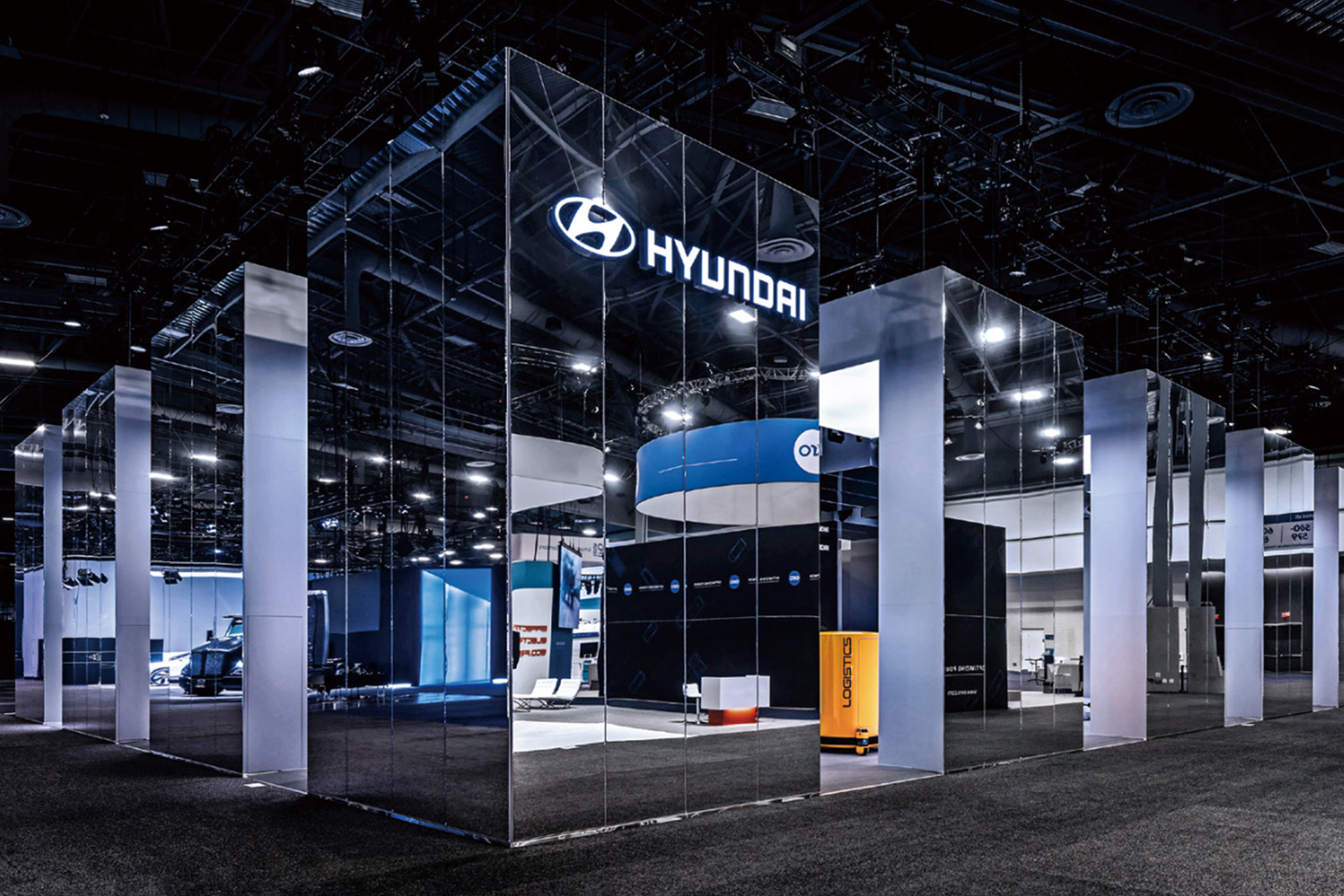
박지무 기획 팀장 / 김혜임 대리
JayPark (Team Leader), Hye Im Kim (Assistant Manager)
니즈스페이스디자인 Nizspace Design

한국전시디자인 연감 우수작 수상을 축하드립니다. 간략한 본인 소개 부탁드립니다.
안녕하십니까? 저는 니즈 스페이스 디자인 기획 팀장 박지무라고 합니다. 현재 본사에서 6년째 근무하고 있으며, 현대자동차 부스 디자인을 주로 담당하였습니다. 2022 CES 현대차 부스 ‘이동 경험의 영역을 확장하다’가 우수작으로 선정되어 기쁩니다.
현대차는 2022 CES에서 ‘이동 경험의 영역을 확장하다’ 주제로 부스를 디자인하셨습니다. 이번 디자인 콘셉트를 도출하며 가장 중요하게 생각했던 것은 무엇인지 말씀 부탁드립니다.
CES라는 쇼 형식에 맞게 현대자동차의 비전을 보여주는 것이 중요했습니다. CES는 가까운 미래에 펼쳐질 기업의 비전 전략에 관한 이야기를 다루는 곳입니다. CES에 맞게 현대자동차도 ‘이동 경험의 영역을 확장하다’라는 주제로 모빌리티와 인류가 함께 진화하는 미래를 보여주고자 했습니다.
현대차의 미래 기술을 매력적으로 소개하기 위해 특별히 신경 쓰신 점이 있는지 궁금합니다. 또한, 미래 기술의 어떤 점을 가장 부각시키고 싶었는지도 말씀 부탁드립니다.
현대자동차가 전하고 싶었던 것은 기술이 우리 생활에 들어오게 되면서 생기는 작은 변화에 관한 이야기였습니다. 아주 먼 미래가 아니라 곧 우리 일상에 스며들 기술을 소개하는 자리였죠. 그래서 전시 공간도 가까운 미래의 기술들을 직관적으로 느낄 수 있게 연출했습니다. 현대자동차의 미래 기술을 과장하지 않고 최대한 담담하게 풀어내는 방식을 선택했고, 공간의 유기적인 연결을 통해 모빌리티의 확장을 체험할 수 있도록 연출했습니다.
리얼리티 존과 메타버스, 그리고 로보틱스 존으로 구성되는 전시 공간의 유기적인 연결을 위해 어떤 점을 가장 중요하게 생각하셨는지 궁금합니다. 또한, 이렇게 연결되는 유기적인 전시를 통해 전달하고 싶은 것은 무엇이었는지도 말씀 부탁드립니다.
전시 공간을 유기적으로 스토리텔링하여 현대차의 비전을 직접적으로 보여주고자 했습니다. 리얼리티 존에서는 사물 모빌리티를 통하여 모빌리티의 새로운 정의를 보여주고, 로보틱스 존에서는 모빌리티를 통해 좀 더 나아진 라이프스타일의 변화를 연출했습니다. 그리고 메타버스 존에서는 가까운 미래에 볼 수 있는 메타모빌리티를 보여주었죠. 이를 통해 현대차의 가까운 미래를 하나의 선형적 스토리텔링으로 구성하여 사람들이 점층적인 경험을 통해 현대차가 제시하는 컨텍스트를 체험하고, 현대차가 제안하는 미래에 깊은 공감을 이끌어낼 수 있기를 바랐습니다.
미래와 현실을 잇는 접점으로 ‘거울’을 선택한 점이 흥미로웠습니다. ‘거울’이라는 아이디어는 어디서 얻으셨는지, ‘거울’을 통해 전달하고 싶은 메시지는 무엇이었는지 궁금합니다.
전시 아이디어를 구상하다가 하나의 이미지를 발견했습니다. 사람이 테이블에서 식사를 하고 있는 그림이었는데, 빔프로젝터로 가상의 인물을 만들어 마치 같이 식사하고 있는 것 같은 느낌을 주는 그림이었죠. 이 그림을 보고 거울이 떠올랐습니다. ‘실제적인 나’와 ‘거울에 비치는 나’, 그리고 ‘사람들이 돌아다니는 모습을 바라보는 나’ 등. 전시 공간에 있는 거울을 통해 여러 가지의 ‘나’를 보여주면 메타버스적인 공간을 연출할 수 있지 않을까라는 생각이 들었습니다. 거울을 통해 CES가 말하는 가까운 미래를 표현하고도 싶었습니다. 거울에 비치는 CES의 여러 전시 부스를 통해 이곳이 우리의 ‘가까운 미래다’라는 의미를 담고 싶었죠.
LED를 통해 미래 기술에 대한 친절한 설명을 전달했는데요, LED 상영이 평면적으로 보이지 않도록 공간에도 많은 신경을 쓰신 것 같습니다. 공간을 연출하기 위해 어떤 디자인 요소를 사용하셨는지, 이것을 통해 어떤 느낌을 만들고자 하셨는지 궁금합니다.
전시품의 수량에 비해 전시 공간이 다소 협소했습니다. 제한된 공간을 극복하기 위해 기술에 대한 정보를 스크린에 연출했고, 제품은 그라운드에 배치하여 새로운 축의 관람 형태를 구성했습니다. 대신 LED 상영이 단조롭게 느껴지지 않도록 분할된 화면에서 각각의 제품 정보를 보여주고, 분할된 화면이 이어지는 전체 스크린에서는 현대차의 비전을 담은 하나의 영상을 상영했습니다. 또한, 이를 통해 ‘이동 경험의 영역을 확장하다’라는 주제로 연결되는 전시의 선형적인 구조를 다시 한번 강조했습니다.
CES 현대차 부스를 제작하며 현실적인 어려움은 없었는지 궁금합니다. 어떻게 어려움을 극복했는지도 말씀 부탁드립니다.
어려움은 상당히 많았습니다. 그중에서도 부스 외관에 사용되었던 미러 바리솔 때문에 고생했던 기억이 가장 강렬합니다. 전시 부스의 외관을 거울처럼 연출하기 위해 거울같이 보이는 미러 바리솔을 이용했는데, 바리솔이 비닐 같은 패브릭 종류여서 주름이 많이 졌습니다. 그래서 전시 시작 전까지 헤어드라이기로 미러 바리솔의 주름을 펴야만 했죠. 다행히 팀원들이 열심히 노력해 줘서 팽팽해진 미러 바리솔과 함께 무사히 전시를 시작할 수 있었습니다.
끝으로 전시 부스 디자이너의 꿈을 키우고 있는 많은 후배 디자이너에게 당부하고 싶은 말씀과 그들이 전시 부스 디자이너로 성장하기 위해 가져야 할 필수 역량에 대한 조언을 부탁드립니다.
최근에 느끼는 것은 전시의 트렌드가 빠르게 변화하고 있다는 것입니다. 예전에는 형태적인 것, 미학적으로 아름다운 것이 좋은 디자인이었다면, 지금은 좀 더 마케팅적인 접근이 필요합니다. 디자인적으로도 사람들을 끌어당길 수 있는 이야기가 있어야 하죠. 앞으로 디자이너를 꿈꾸는 사람이라면 시각적인 것에서 나아가 다양한 분야를 두루 공부하고 그 내용을 작업에 펼칠 수 있는 능력을 키우는 것이 중요할 것 같습니다.
Congratulations on winning the Good Design in the Korea Exhibition Design Annual. Please briefly introduce yourself.
Hi. I am Jay Park, head of design planning at Nizspace. I’ve worked at Nizspace for six years, taking charge of the booth design for Hyundai Motor Company. I am very pleased to hear that Hyundai’s “Expanding Human Reach” booth at CES 2022 was selected as the winner of Good Design.
You designed the Hyundai booth for CES 2022 under the theme of “expanding human reach.” What did you consider the most important when deciding the design concept this time?
I considered that showing the vision of Hyundai according to the format of CES was the most important. CES is the place where companies unveil their vision and strategies for upcoming future. Hyundai also wanted to show the future where mobility and people evolve together under the theme of “expanding human reach” in line with the concept of CES.
Was there a part that you paid special attention to explain future technologies of Hyundai to make them look attractive? Which elements of future technologies did you want to emphasize?
Hyundai wanted to talk about small changes in our daily lives as we were accustomed to its technologies. It’s not about something that will happen in a distant future. Rather, it was to introduce technologies that would soon become a part of our daily lives. To emphasize that point, we designed the exhibition space where visitors can feel future technologies intuitively. We tried to explain the future technologies of Hyundai as simple as we could, instead of exaggerating them. We also connected spaces systematically so that people could experience the expanded mobility.
What did you consider the most important when you decided to systematically connect the exhibition spaces comprising the reality, robotics and metaverse zones? What message did you want to deliver through the exhibition via the systematically connected spaces?
First, I wanted to show the vision of Hyundai directly through the storytelling of systematic connection of exhibition spaces. To make this happen, I designed the reality zone to describe a new definition of mobility through the “mobility of things” (MoT), depicted lifestyles that have changed in a better way through mobility in the robotics zone, and described metamobility that may unfold in a distant future in the metaverse zone. Through the three zones, the near future of Hyundai was developed as a linear storytelling to allow people to experience the context through the incremental experience and deeply understand the future proposed by the company.
I was deeply impressed by your choice of “mirror” as a focal point connecting future with the reality. Where did you get the idea of the “mirror” and what message did you want to convey?
As I explore ideas for the booth design, I came across an image of a man having dinner at a table, but it looked like he was having dinner with others that were virtual figures cast by a beam projector. This reminded me of the mirror stage—the self (ego), the other(imago), and the Other (looking at others around). I came up with the idea that it could be possible to create a metaverse space by showing the self in the exhibition space in various versions though the mirror. Also, I wanted to express a distant future of CES through the mirror. In other words, I intended to explain people that where we are is the “near future” through various exhibition booths at CES reflected in the mirror.
You kindly explained about future technologies through LED. It appeared that you cared a lot about the space so that LED video screens were not to look plain. What kind of design elements did you use to create the space? What kind of feeling did you want that these elements would bring?
It was true that the space was not large enough to display all items we had. To overcome the spatial limit, we decided to create videos about the information on technologies and display products on the ground to have a vertical axis for viewers. Instead, product information was shown on split screens so that the LED videos did not look monotonous, and the full screen connected from split screens played a video related to the vision of Hyundai. Again, I emphasized the linear structure of the exhibition that led to the main theme of “expanding human reach.”
Did you have any difficulties in constructing the Hyundai booth at CES 2022 in practice? How did you overcome such challenges?
We had faced many challenges. One of the challenges that we faced was related to Barrisol Mirror® that was used to the exterior of booth. It was the most intense experience. We used Barrisol Mirror® as we wanted to make the exterior of booth look like a mirror. It had many wrinkles as it was made of a fabric material similar to vinyl. So, we had to use hair dryers to press out the wrinkles before the exhibition began. Thankfully, our team members worked hard so we were able to start the exhibition with stretched Barrisol Mirror®.
Do you want to say something to future exhibition booth designers? Please give your advice on the capabilities that booth designers must have.
I recently felt that the trends of exhibition changes fast. Things having physical meanings and things with aesthetic beauty were considered to have a good design in the past. Today, we need to have a different approach to create a booth design from the marketing perspectives. Also, you should have stories that appeal to audiences when it comes to design. If you want to be a designer, I recommend you to study various fields and build your skills to transform your learning into design, rather than focusing on exploring visual aesthetics.

